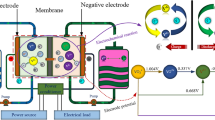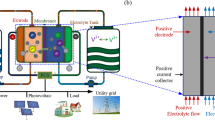Abstract
A battery's performance and efficiency are greatly influenced by the electrolyte flow rate. By increasing the flow rate, the pump power loss will increase, leading to a decrease in system efficiency. Pressure losses in vanadium redox flow batteries (VRFB) systems happen as electrolyte moves across the surface of the electrode. The biggest pressure loss will occur in the porous electrode, which will reduce system efficiency and impact battery performance. A vanadium redox flow battery’s pressure drop is studied through simulations of various performance parameters such as flow rate, viscosity, porosity, electrode thickness, channel height, channel width, and no of channels. As seen, the relationship between pressure drop and flow rate is linear. A increase in channel width from 2 to 3 mm is seen to decrease the pressure drop by a value of 3 for the same flow rate. Simulation results indicate that when the number of channels is doubled, the pressure drop increases by a factor of 8 under constant flow rate. The pressure drop is found to vary significantly when the electrode thickness varies from 2 to 6 mm. Additionally, we noticed that as the height of the channels grows, the pressure varies significantly. Model results are compared to experimental data and found to compare well.












Similar content being viewed by others
Data availability
Data will be provided on request.
Abbreviations
- \(u\) :
-
Velocity of electrolyte flow (m/s)
- \(\rho\) :
-
Electrolyte density (Kg/m3)
- \(p\) :
-
Pressure of the fluid (Pa)
- \(\varepsilon\) :
-
Porosity
- \(\mu\) :
-
Viscosity (Pa.s)
- \({\beta }_{F}\) :
-
Forchheimer drag coefficient
- \(F\) :
-
Volume force vector (N)
- \(k\) :
-
Permeability (m2)
- \({K}_{ck}\) :
-
Kozeny-Carman constant
- \({d}_{f}\) :
-
Fiber diameter (m)
- L:
-
Length of the electrode (m)
- W:
-
Width of the electrode (m)
- T:
-
Thickness of the electrode (m)
- Chw :
-
Channel width (m)
- rw :
-
Rib width (m)
- \(\nabla\) :
-
Del Operator
- VRFB:
-
Vanadium redox flow batteries
References
Alia E, Kwon H, Choi J, Lee J, Kim J, Park H (2020) J Energy Storage 28:101208
Bogodonov S, Vorobhev P (2023) Mechano-electrochemical coupling in flexible all-solid-state lithium metal batterie. J Energy Storage 57:106191
Bures M, Gotz D, Mazur P (2024) Evaluation of mitigation of capacity decay in vanadium redox flow batteries for cation-and anion-exchange membrane by validated mathematical modelling. J Power Sources 591:233769
Cecchetti M, Toja F, Casalegno A, Zago M (2023) A comprehensive experimental and modelling approach for the evaluation of cross-over fluxes in Vanadium Redox Flow Battery. J Energy Storage 68:107846
Chalamala BR, Soundappan T, Fisher GR, Anstey MR, Viswanathan VV, Perry ML (2014) Redox flow batteries: an engineering perspective. Proc IEEE 102:976–999
Darling RM, Perry ML (2014) Influence of architecture and material properties on vanadium redox flow battery performance. J Electrochem Soc 161:A1381–A1387
García-Salaberri PA, Gokoglan TC, Ibanez SE, Agar E, Vera M (2020) Modeling the effect of channel tapering on the pressure drop and flow distribution characteristics of interdigitated flow fields in redox flow batteries. Processes 8(7):775
Gostick JT, Fowler MW, Pritzker MD, Ioannidis MA, Behra LM (2006) In-plane and through-plane gas permeability of carbon fiber electrode backing layers. J Power Sources 162:228–238
Gundlapalli R, Jayanti S (2019) Effect of channel dimensions of serpentine flow fields on the performance of a vanadium redox flow battery. J Energy Storage 23:148–158
Gundlapalli R, JayantiJ S (2021) Dataset on performance of large Vanadium redox flow batteries with serpentine flow fields. Power Sources 494:29753
He Q, Li Z, Ni M (2023) A 3D modelling study on all vanadium redox flow battery at various operating temperatures. Energy 282:128934
Houser J, Clement J, Pezeshki A, Mench MM (2016) Influence of architecture and material properties on vanadium redox flow battery performance. J Power Sources 302:369–377
Huang Z, Mu A, Wu L, Wang H, Zhang Y (2021) J.Power sources
Jyothi Latha T, Jayanti S (2014) Hydrodynamic analysis of flow fields for redox flow battery applications. J Appl Electrochem 44(9):995–1006
. Kays WM, Crawford ME Convective Heat and Mass Transfer, McGraw-Hill
Kumar S, Jayanthi S (2016) Effect of flow field on the performance of an all-vanadium redox flow batter. J Power Sources 307:782–787
Kumar S, Jyothi Latha T, Jayanti S (2018) Experimental studies of permeability measurement and hydrodynamics study of all-Vanadium redox flow battery. Mater Today Proceed 5:23169–23176
Lee J, Kim J, Park H (2019) Numerical simulation of the power-based efficiency in vanadium redox flow battery with different serpentine channel size. J Hydrogen Energy 44:29483–29492
Leung P, Li X et al (2012) Progress in redox flow batteries, remaining challenges and their applications in energy storage. RSC Adv 2:10125
Maharudrayya S, Jayanti S, Deshapande AP (2004) Pressure losses in laminar flow through serpentine channels in fuel cell stacks. J Power Sources 138:1–13
Messaggi M, Canzi P, Mereu R, Baricci A, Inzoli F, Casalegno A, Zago M (2018) Analysis of flow field design on vanadium redox flow battery performance: Development of 3D computational fluid dynamic model and experimental validation. Appl Energy 228:1057–1070
Pourrahmani H, Zahedi R, Daneshgar S (2023) Effect of flow field on the performance of an all-vanadium redox flow battery. J Van Herle Energies 16:3761
Qijiao He JYu, Ni M (2021) Modeling of vanadium redox flow battery and electrode optimization with different flow fields. Adv Electr Eng Electron Energy 1:100001
Shyam Prasad KB, Suresh PV, Jayanti S (2009) A hydrodynamic network model for interdigitated flow fields. J Hydrogen Energy 34:8289–8301
Tomadakis MM, Robertson TJ (2005) Viscous permeability of random fiber structures: comparison of electrical and diffusional estimates with experimental and analytical results. J Compos Mater 39:163
Weber AZ, Mench MM, Meyers JP, Ross PN, Gostick JT, Liu Q (2011) Redox flow batteries: a review. J Appl Electrochem 41:1137–1164
Xu Q, Zhao TS, Leung PK (2013a) Numerical investigations of flow field designs for vanadium redox flow batteries. Appl Energy 105:47–56
Xu Q, Zhao TS, Leung PK (2013b) Appl Energy 105:45–56
You D, Zhang H, Chen J (2009) A simple model for the vanadium redox battery. Electrochem Acta 54:6827–6836
Zhao X, Jung S (2023) Long-term capacity fade forecasting of vanadium redox flow battery with Gaussian process regression combined with informer model. J Power Sourc 585:233670
Acknowledgements
We wish to acknowledge the CSIR research grant (22/0784/19/EMR II) and BITS Pilani, Hyderabad for providing the required support to publish this paper.
Author information
Authors and Affiliations
Corresponding author
Ethics declarations
Conflict of interest
None.
Additional information
Publisher's Note
Springer Nature remains neutral with regard to jurisdictional claims in published maps and institutional affiliations.
Rights and permissions
Springer Nature or its licensor (e.g. a society or other partner) holds exclusive rights to this article under a publishing agreement with the author(s) or other rightsholder(s); author self-archiving of the accepted manuscript version of this article is solely governed by the terms of such publishing agreement and applicable law.
About this article
Cite this article
Yadav, S., Krishnamurthy, B. Vanadium Redox Flow Batteries-Pressure Drop Studies in Serpentine Flow Field Configuration. Trans Indian Natl. Acad. Eng. (2024). https://doi.org/10.1007/s41403-024-00467-6
Received:
Accepted:
Published:
DOI: https://doi.org/10.1007/s41403-024-00467-6




